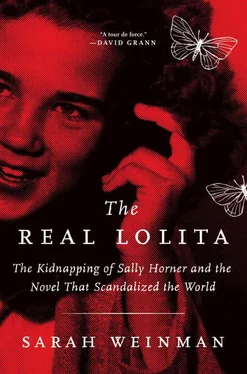When he first sees her, Humbert Humbert describes Dolores in poetic terms: “frail, honey-hued shoulders… silky supple bare back… chestnut head of hair” and wearing “a polka-dotted black kerchief tied around her chest” that shields her breasts from Humbert’s “aging ape eyes.”
Humbert confides to the reader that when he was nine, he met a girl named Annabel Leigh, also nine. They embarked on a friendship with strong romantic overtones and multiple rendezvous by the beach. Then Annabel fell ill and died prematurely, the idyll forever cut short. Her death imprinted a type, and a predilection, upon Humbert for the rest of his days. Girls who fall between the ages of nine and fourteen. Girls whose “true nature,” according to Humbert, bore little resemblance to real life. Girls he characterized as “little deadly demons.” Girls immortalized, forevermore, by him as well as his creator, as nymphets.
Humbert Humbert was describing a compulsion. Vladimir Nabokov set out to create an archetype. But the real little girls who fit this idea of the mythical nymphet end up getting lost in the need for artistic license. The abuse that Sally Horner, and other girls like her, endured should not be subsumed by dazzling prose, no matter how brilliant.
The seeds of Sally Horner’s kidnapping grew out of choices made by her mother. Ella kept secrets about the circumstances of her daughters’ births and the death of Sally’s father. Sally never knew of them. Susan may have, but if so she never spoke of them to her family. Digging up these secrets transformed me into an accidental forensic genealogical detective. I spent so many months stuck on Sally’s origin story and the clash between what was reported and what really happened because I thought it would help me better understand Ella’s behavior.
Her decisions, with respect to Sally’s disappearance, hold her up to severe scrutiny by the modern world. She let her daughter go off with a stranger she’d only spoken to by telephone. She grew more distant, perhaps more baffling, to her family, let alone to neighbors. She fit the pejorative “difficult” bill so often affixed to women who don’t fit within neat little boxes. But in 1948, with little money and fewer resources available to Ella as a single mother, she functioned within her own limited framework. Her best was not good enough for Sally, but it was all she knew based on the life she’d lived up until she saw her daughter off at the Camden bus depot.
SALLY WAS HER NICKNAME. No one is alive to remember why, or who used it first, or how it stuck. Her legal name, listed on the certificate announcing her birth at Trenton Hospital on April 18, 1937, was Florence, no middle name, Horner. Her mother, the former Ella Katherine Goff, took the baby back to the home she shared with Russell Horner in Roebling, New Jersey. The house at 238 Fourth Avenue is long gone, replaced by a more modern town house a stone’s throw from the River Line train station to the east, and several blocks south of the Delaware River.
Ella’s older daughter, Susan, also lived with the Horners, though Russell was not her father. Eleven years earlier, at the age of nineteen, Ella had had some sort of relationship with an older man of about thirty. When the subject came up, Ella told her family that she and Susan’s birth father, whom she never named, were married, but that he passed away. Susan knew her father’s real name, William Ralph Swain, because she listed it on her marriage license. She likely knew little else.
Ella had good reason to keep Swain’s existence a secret, and never mention him by name. Records indicate he was married to someone else when Susan was born, contrary to the “yes” ticked off on Susan’s birth certificate, indicating her legitimate status. Nor could I find any existing marriage record between Swain and Ella, though one may turn up in the future—vital records are irregularly stored from city to city, state by state. To confuse matters further, the 1930 census listed Ella’s last name as Albara, which she used for at least a half dozen more years. The census record also listed her as being married, but I could not track down any marriage record between Ella and a man named Albara.
Ella raised Susan on her own, with occasional help from her parents, Job and Susannah Goff. One subject they all fretted about was how long it took Susan to learn to speak. She’d had some sort of head injury as a baby, and did not begin talking in earnest until she was five, by which time she and her mother had moved to Prospertown to be closer to Ella’s parents, who were growing older and more infirm.
That’s where Ella met Russell Horner, a widower with a son, also named Russell. Horner began to court her, and some of their meetings were recorded by the local papers, as was the custom of the day. On December 9, 1935, the Asbury Park Press noted that Ella and Russell were “recent visitors to friends in Lakehurst.” The paper also reported on June 8, 1936, that Ella and Susan visited Russell and his son (both names were spelled as “Russel”) in New Egypt, and noted a solo visit by Ella to the town on August 8. Ella and Russell were not husband and wife, though. It seems Ella had repeated the pattern begun with Swain. While Russell’s first wife, the mother of his son, had died, he had married a second time and never bothered to divorce the woman. By the end of 1937, Russell and Ella were living as husband and wife at the Fourth Avenue house in Roebling.
As for Russell Junior, he married two months before Sally Horner’s birth. Sally never knew of her half brother’s existence. Neither her mother nor Susan mentioned him.
Ella and Russell’s domestic arrangement was as short-lived as their earlier relationships. By the time Sally was about three, the situation had grown volatile. Russell had a drinking problem, which did not mix well with his job as a crane operator, and he could be abusive to his wife and her daughters. Susan remembered the beatings her stepfather gave her mother, memories she did not allow herself to think about until close to the end of her own life. Sally, much younger when her parents split up, may have been spared the worst of these memories.
Eventually, Ella fled her relationship. She took Susan and Sally to Camden, where they moved into the town house at 944 Linden Street. Russell became itinerant, drifting from town to town around southern New Jersey, looking for and not finding work. He lost his driver’s license when caught taking a shortcut along some railroad tracks. By the beginning of 1943, he was living at his parents’ farm in Cassville. On March 24, he hanged himself from the rafters of the garage. Horner left a note for his mother in the kitchen, directing her where to find his body. According to the state police, he “had been despondent over ill health for some time.”
Police told the Asbury Park Press that Russell had been married twice and was “estranged from his current wife,” though they did not say whether the wife in question was Ella. But the address listed on Russell’s death certificate was the address where he’d lived with Ella and the girls in Roebling. And the name of his daughter, “Florence,” is handwritten just below the address line.
Sally was not quite six years old when her father committed suicide. It isn’t clear how much she knew of her father’s history and manner of death. Later, when it became necessary to clarify her parentage, she said, “My real daddy died when I was six and I remember what he looks like.”
After Russell killed himself, Ella, already living as a single mother, was truly on her own. Her mother, Susannah, had passed away in 1939, while her father, Job, died in January 1943, just two months before Russell killed himself. Ella had to go to work as a seamstress.
Читать дальше












